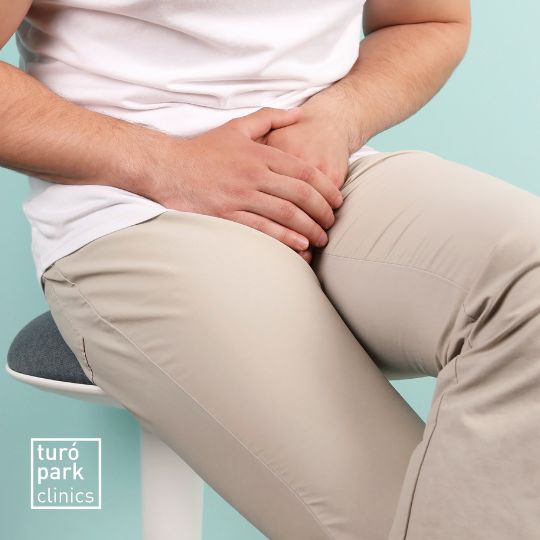Looking for the help of an specialist in Barcelona?
Urinary incontinence affects nearly 1 in 3 people during their lifetime. While the condition can occur at any age, it is more common among older adults (aged 50 or more), especially women. However, urinary incontinence isn’t a normal part of aging. Instead, it stems from underlying issues–such as a weak urinary bladder or pelvic floor muscles, urinary tract or vaginal infections, or more severe conditions like neurological disorders.
Fortunately, several effective treatments are available to address urinary incontinence. At Turó Park Clinics, our healthcare professionals can help you understand the root cause of your urinary incontinence and choose the right treatment option that will have the least impact on your overall well-being.
Bladder control issues can be embarrassing and disrupt your daily life. However, it can be stopped or controlled. Whether you are experiencing urine leakage while coughing, frequent urges to use the toilet, or interrupted sleep due to frequent bathroom visits, let our experts help.
What Is Urinary Incontinence?
Urinary incontinence refers to the involuntary leakage of urine from the bladder. In simple words, a person with urinary incontinence struggles to control or hold their urine. While there are several causes of urinary incontinence, it usually happens in older people due to an overactive bladder (OAB).
The urinary bladder is a hollow organ located in the lower abdomen that stores urine. It forms an integral part of the urinary system comprising kidneys, ureters, and urethra. When a person urinates, the brain sends signals to the bladder resulting in the muscles in and around the bladder tightening and the urine flowing into the urethra. Simultaneously, the muscles around the urethra relax to allow the urine to flow out of the body. When these muscles don’t work the way they should, they contribute to urinary incontinence.
Fast track your treatment
To book an appointment or speak with one of our friendly team, please get in touch using the options below

What Are The Causes Of Urinary Incontinence?
Urinary incontinence can happen for several reasons. It might be temporary when it lasts short-term and is caused by any changes in the body function that results from infections (urinary tract or vaginal infection), certain diseases (constipation), specific medications (diuretics, muscle relaxants), or even foods (alcohol, caffeine, chili peppers, citrus fruits, etc.).
Women are most likely to develop incontinence after childbirth or menopause, or during pregnancy. Nevertheless, when incontinence lasts longer, it might be due to:
- Weak pelvic floor muscles or bladder or an overactive bladder (OAB)
- Neurological diseases like multiple sclerosis, spinal cord injuries, and Parkinson’s disease that damage the nerves controlling the bladder.
- Chronic conditions like diabetes or constipation that weaken the pelvic floor muscles or exert pressure on the bladder.
- Pelvic organ prolapse, where the organs of the pelvis (bladder, uterus, rectum, etc.) shift out of their usual place, making the bladder and urethra unable to function normally and causing the urine to leak.
- An obstruction, such as a tumor or stones, irritates the urinary tract, causing urgency, frequency, and urge continence.
Urinary incontinence in men is often related to an enlarged prostate that affects the voiding capacity of the bladder and can cause urge urinary incontinence.
What Are The Different Types Of Urinary Incontinence?
A lot of people experience incontinence or urine leakage while coughing occasionally. Others might experience it more frequently. Here are different types of urinary incontinence you should be aware of.
Stress incontinence occurs as a result of pressure put on the bladder by physical activities such as coughing, sneezing, laughing, exercising, or lifting heavy objects. It is the most common type of incontinence experienced by women.
As the name suggests, urinary incontinence involves a sudden and intense urge to urinate and the inability to hold urine long enough to get to the toilet. Sometimes, it can be a separate condition triggered by specific stimuli like running water.
Overflow incontinence refers to a condition where the quantity of urine produced exceeds the capacity of the urinary bladder. Hence, the bladder doesn’t empty completely during urination or is always full, and you experience constant or frequent dribbling of urine. This type of urinary incontinence is more common in men due to an enlarged prostate blocking the urethra. Nevertheless, spinal cord injuries, as well as diabetes, can also cause this overflow incontinence.
Mixed incontinence refers to experiencing a combination of two or more types of urinary incontinence. In most cases, it is a combination of stress and urge incontinence.
Your health is our priority.
Our team of urologists treats urinary tract disorders in women and men.

What Are The Symptoms Of Urinary Incontinence?
Urinary incontinence can manifest in various ways, and the symptoms may vary from one person to another. Here are some of the common symptoms of urinary incontinence to look for.
- Urine leakage while coughing, sneezing, or performing other physical activities.
- Sudden, strong urges to urinate or inability to hold urine until you get to the toilet.
- Needing to urinate more often than usual.
- Having to wake up multiple times during the night to urinate.
- Continuous or intermittent leakage of urine, even after urinating.
It is important to remember that a few symptoms of urinary incontinence resemble other medical conditions. Hence, it is highly recommended that you seek medical advice from a healthcare professional for proper diagnosis, who will prescribe the right treatment option based on your specific symptoms and needs.
How Is Urinary Incontinence Treated At Turó Park Clinics?
At Turó Park Clinics, treatment for urinary incontinence begins with a consultation with the primary care physician or general physician. After the initial evaluation, you will be referred to a urologist (a doctor who specializes in diagnosing and treating conditions affecting the urinary system) or a gynecologist (a doctor who specializes in diagnosing and treating conditions affecting the female reproductive system). This is to ensure you receive targeted and specialized care for your specific condition.
When it comes to treatment options, the specific treatment will be determined by your doctor based on your age, medical history, overall health, type of incontinence, tolerance to specific medications, personal preference, etc. Urinary incontinence treatment may include:
- Behavioral Therapy – Bladder training, urgency suppression, and toilet assistance.
- Lifestyle Changes – Dietary adjustment, weight management, and fluid management.
- Medications – Anticholinergics, hormone therapy, and bulking agents.
- Physiotherapy – Vaginal weight training, Kegel exercises, and pelvic floor electrical stimulation.
- Surgery – Bladder suspension, slings, peripheral nerve stimulation, and injections with neuromodulators in the bladder wall.
Also known as intravesical neuromodulator therapy, injections with neuromodulators in the bladder wall are used to treat an overactive bladder and urgency incontinence. During the procedure, a healthcare professional injects neuromodulators into the detrusor muscle (the muscle lining the bladder) using a cystoscope, a thin tube inserted through the urethra. Neuromodulators work by inhibiting muscle contractions, giving you more time to get to the bathroom when you need to urinate.
Sometimes, people who fear surgical urinary incontinence treatment will be advised to rely on protective pads, diapers, and shields to manage the condition.
You might feel uncomfortable discussing urinary incontinence with a doctor. However, it is essential to seek help and treatment if the condition is frequent and affects the quality of your everyday life.
At Turó Park Clinics, we prioritize patient-centered care, which means ensuring you are comfortable and involved in the decision-making process. So, book a consultation with us today, and let us help you regain control over your life.
Our English-speaking urologists

